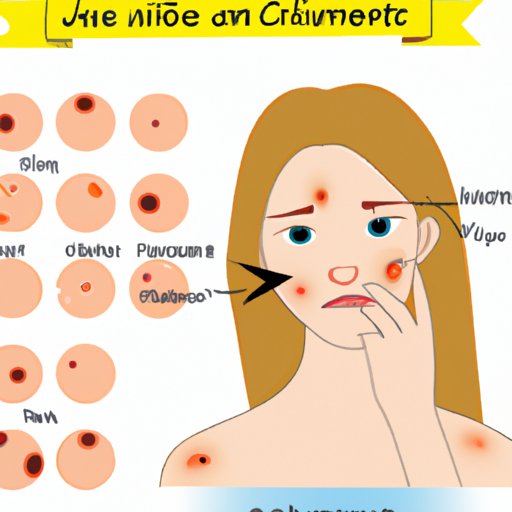Introduction
Fungal acne, also known as pityrosporum folliculitis, is a skin condition caused by an overgrowth of yeast on the skin. It can cause red, itchy bumps on the skin, similar to regular acne. However, it’s important to differentiate between the two, as they require different treatment plans.
In this article, we will be exploring the various causes of fungal acne. We will analyze the role of hygiene and prevention, diet and nutrition, stress, hormones, skincare products, and climate in developing fungal acne. By understanding the underlying causes and risk factors, you’ll be better equipped to prevent and treat the condition.

Analyzing the Causes of Fungal Acne: What You Need to Know
When it comes to fungal acne, there are several potential causes that can contribute to its development. Let’s take a look at each one in more detail.
Hygiene and Prevention
Good hygiene is essential for preventing fungal acne. Washing your face twice a day with a gentle cleanser can help keep your skin free from impurities and excess oils. Avoiding overly hot showers and baths can also help, as high temperatures can strip the skin of its natural oils and disrupt the delicate balance of bacteria on the skin.
It’s also important to avoid sharing towels, clothing, and other items with someone who has fungal acne, as this can spread the infection. Finally, keeping your hair off your face can help reduce the chances of fungal acne flare-ups.
Diet and Nutrition
Your diet and nutrition can also play a role in the development of fungal acne. Eating a healthy, balanced diet with plenty of fresh fruits and vegetables can help keep your skin clear. It’s also important to avoid foods that are high in sugar and refined carbohydrates, as these can lead to an increase in yeast production on the skin.
Stress
Stress can also have an impact on fungal acne. When you’re stressed, your body releases cortisol, which can lead to an increase in oil production and clogged pores. This can create an ideal environment for the growth of yeast on the skin. Reducing stress levels through activities like exercise, yoga, and meditation can help keep your skin clear.
Hormones
Hormonal changes can also contribute to fungal acne. During puberty, pregnancy, and menopause, hormone levels can fluctuate, leading to an increase in oil production and clogged pores. This can create an ideal environment for the proliferation of yeast on the skin. If you’re experiencing hormonal changes, it’s important to take extra care of your skin to prevent fungal acne.
Exploring the Impact of Skincare Products on Fungal Acne
The ingredients in your skincare products can also play a role in the development of fungal acne. Certain ingredients, such as mineral oil and petrolatum, can block the pores and create an ideal environment for the growth of yeast. Furthermore, fragrances and preservatives can be irritating to the skin and can worsen existing fungal acne.
Ingredients to Avoid
When choosing skincare products, it’s important to read the label and avoid any products containing mineral oil, petrolatum, fragrances, or preservatives. Instead, opt for products that are specifically formulated for sensitive skin, as these are less likely to clog the pores and cause irritation.
Recommended Products
When it comes to fungal acne, it’s best to use products that contain antifungal ingredients, such as tea tree oil, aloe vera, and witch hazel. These ingredients can help control the overgrowth of yeast on the skin and reduce inflammation. Additionally, using a moisturizer with hyaluronic acid can help keep the skin hydrated and prevent dryness.

Investigating the Role of Climate in Fungal Acne
The climate can also contribute to the development of fungal acne. In humid environments, sweat and dampness can create an ideal environment for the growth of yeast on the skin. Similarly, hot climates can lead to an increase in oil production and clogged pores, creating an ideal environment for yeast overgrowth.
Humidity
High humidity levels can contribute to fungal acne. To protect your skin from the effects of humidity, it’s important to keep your skin clean and dry, using a mild cleanser and avoiding overly hot showers. Additionally, using a light moisturizer can help keep your skin hydrated without clogging the pores.
Temperature
Hot temperatures can also contribute to fungal acne, as they can lead to an increase in oil production and clogged pores. To protect your skin from the effects of heat, it’s important to wear loose, breathable clothing and limit your time in the sun. Additionally, using a light sunscreen can help protect your skin from UV rays.
Conclusion
Fungal acne is a common skin condition caused by an overgrowth of yeast on the skin. There are several potential causes that can contribute to its development, including hygiene and lifestyle habits, diet and nutrition, stress, hormones, skincare products, and climate. By understanding the underlying causes and risk factors, you’ll be better equipped to prevent and treat the condition.
To prevent fungal acne, it’s important to practice good hygiene, eat a healthy, balanced diet, reduce stress levels, and avoid skincare products with irritating ingredients. Additionally, it’s important to protect your skin from the effects of humidity and heat. With the right prevention and treatment plan, you can keep your skin clear and healthy.


